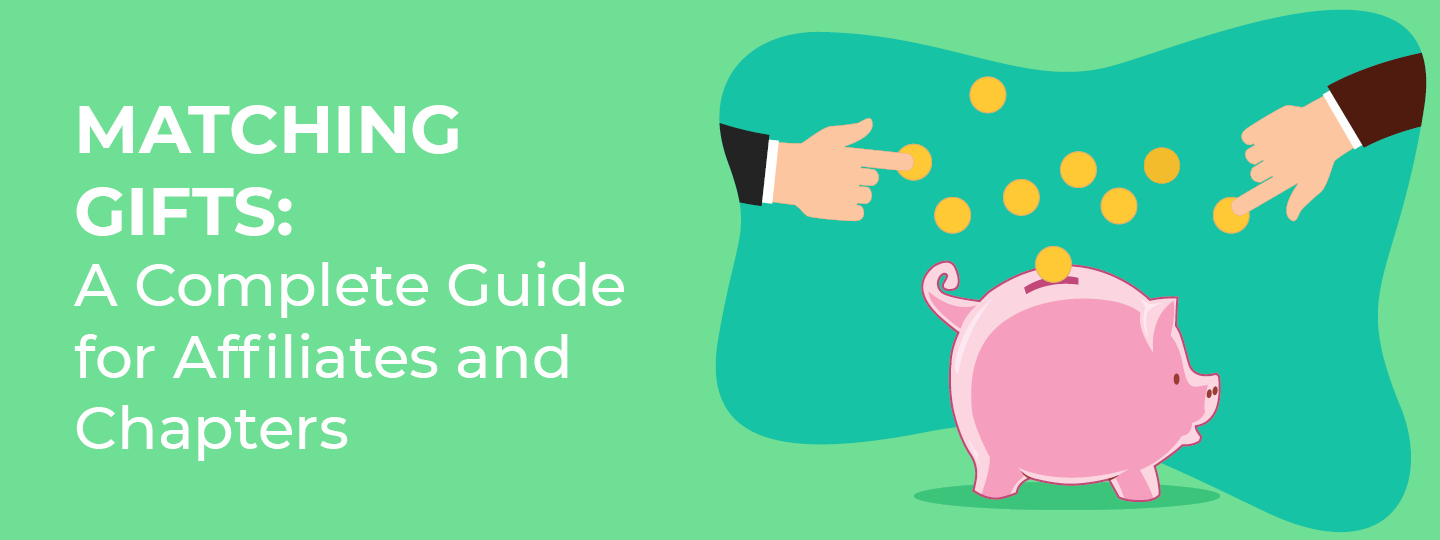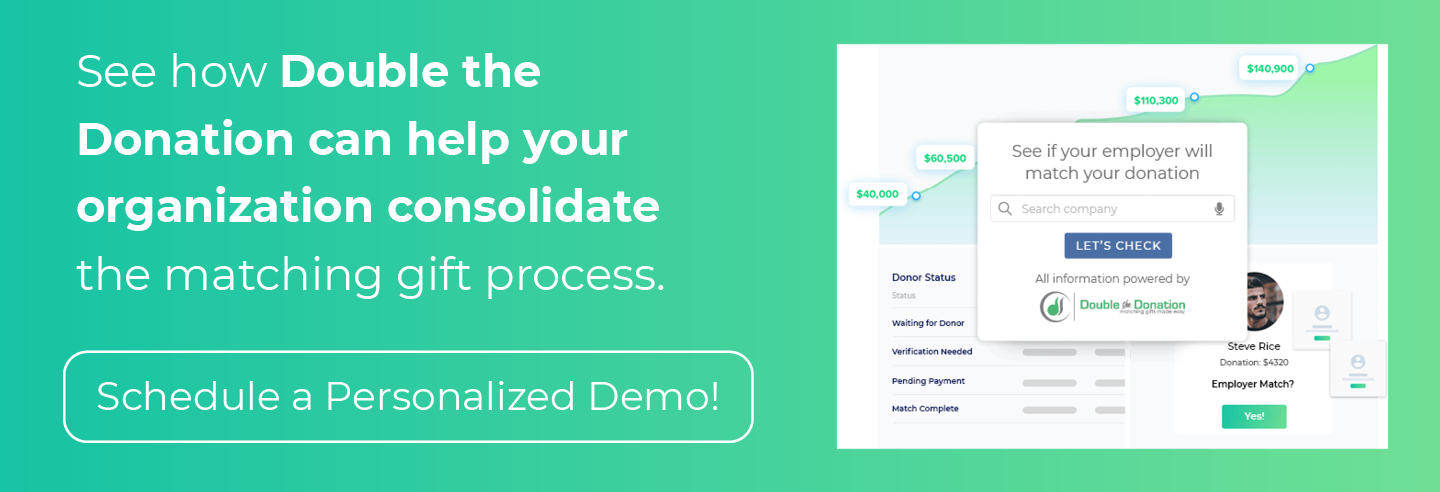Matching Gifts: A Complete Guide for Affiliates and Chapters
Matching gifts are hard enough for grassroots and other small organizations to handle, but when you throw in a complex structure that includes several chapters, it becomes immensely more sophisticated—unless you consolidate the process!
In short, consolidating matching gifts involves all chapters or affiliates following a central strategy for securing and handling these funds. While full consolidation may not be feasible for all organizations, the more you can systematize the process, the better!
Here at Double the Donation, we’ve worked with thousands of nonprofits and have seen all different types of organizational structures. We’re familiar with the pros and cons of each when it comes to defining matching gift procedures and understand that it’s tough to find a perfect solution for every organization. Based on this experience and the conversations we’ve had, we strongly believe in centralizing matching gifts.
In this article, we’ll discuss the step-by-step process for standardization, the benefits of doing so, and common pain points (with actionable solutions!) many organizations that follow this model face. When leveraged correctly, these tips have the power to transform your fundraising strategy organization-wide.
Make the most of the information shared here to reflect on your organization’s performance and enhance your strategies. In no time, you’ll be well on your way to creating a foolproof and standardized strategy, sparking team-wide engagement, and securing more matching gifts.
We’ll take a closer look into the following:
- Consolidating the Process
- Common Barriers Affiliates Face and Actionable Solutions
- Benefits of Matching Gift Standardization
- Concluding Thoughts
Consolidating the Process
Step 1: Assess Your Current Situation.
Knowing where to start can be difficult—especially if you’re brand new to the limitless world of matching gifts. Before you can create an end-to-end solution customized to your nonprofit, you need to know exactly where you currently stand. That is, how does the process currently look for your nonprofit? Is it based on one common solution, or have you left each chapter to its own devices?
Determining how your matching gift strategy is currently structured and how you’d like it to be structured early on is the key first step.
Let’s take a look at 3 common approaches (plus an approach that combines elements of each), some considerations for each, and next steps to successfully implement an effective approach:
| Considerations | Next Steps | |
| Fully Centralized |
|
|
| Centralized by Region |
|
|
| Fully Independent by Chapters |
|
What works for one organization might not work for another. Choose an approach that suits your unique needs. It’s important to note that not every organization has a clear-cut approach. To create a strategy that’s tailored to your team’s needs, you might choose to take elements of each and blend them instead.
No matter your decision, your primary goal should be consolidation. Whether that’s on a national level or on a regional level largely depends on your organization’s needs. However, the more defined and centralized your process is, the less room there is for error and confusion.
Streamline the process across the board, and you’ll be well on your way to gaining organization-wide approval.
Step 2: Develop an Action Plan.
Here comes the most time-intensive part: creating an all-inclusive solution that works across the board, from your largest chapters to the smallest ones.
Headquarters should align the process for affiliates. However, this may lead to some resistance if chapters feel as if they have no say in the matter. So that each affiliate feels as though its voice is heard, assemble a team of affiliate representatives and national representatives. Then, hold a video or phone conference to discuss an organization-wide process.
If you expect anyone to jump on board, you’ll need to plan it from end-to-end. Any gaps could lead to skepticism and doubt in the soundness of your proposed plan. Walk through each of the following questions so that you can create a solution that works across all chapters:
| Questions to Ask | Next Steps | |
| Understanding Current Processes |
|
|
| Putting a Team in Place |
|
|
| Optimizing the Lifecycle |
|
|
| Operational Processes |
|
|
Once you’ve solidified the plan from end to end, lay it out in front of your affiliates. The more information you provide them, the better. This makes for a wider chance that each chapter will adopt the new processes.
Step 3: Continue the Conversation.
Each of your chapters or affiliates has successfully adopted the new procedures. Wonderful!
The conversation doesn’t have to stop just because you’ve fixed the process, though. In fact, once you’ve standardized the process, that’s when you can facilitate strategic conversations about matching gifts. From here, you can grow your strategy to new heights and focus it more on your mission!
To maintain an open line of communication, meet with your team of representatives on a regular basis. Keep the table open for discussion by welcoming new ideas. Initiate an effective conversation by coming prepared with potential topic ideas, including:
- Reviewing and improving the donor journey
- Optimizing portals and portal management
- Creating consistent training for staff and fundraisers
From here, determine how you can quicken the process and maximize efficiency. As you learn what works best, you can refine your strategies and streamline the process even further. Whatever you do, don’t stop discussing matching gifts.
Common Barriers Affiliates Face and Solutions
While each chapter or affiliate may have its own set of unique challenges, there are several common pain points that most encounter. Instead of going in blindly, take time to read up on them now, so you can face them with confidence as they arise.
 Problem: Inconsistent Donor Experience
Problem: Inconsistent Donor Experience
Arguably, the most significant barrier affiliates face is an inconsistent donor experience across the entire organization.
From varying donation forms to different corporate giving vendors to a lack of internal matching gift support, the donor experience can vary widely from chapter to chapter and across the organization as a whole. Overall, this creates a fractured donor experience across the nonprofit.
What it all boils down to is that if donors have a difficult time submitting their donations (and therefore their matches), then they may not donate or submit matches in the future—or even finish submitting their initial contribution in the first place.
Primary Solution: Ensure Identification and Follow-Up.
With centralized matching gift procedures, you’ll need to ensure that individual chapters and affiliates are following through with proper identification and follow-up communications. Set clear guidelines. Then, employ the use of software to streamline the process and make sure no opportunities are missed. The right software will automatically identify match-eligible individuals and conduct the necessary follow-up.
From here, you’ll also want to designate an employee (or even a team) to handle all donor-related matching gift questions. Ensure your staff is well-versed on matching gifts prior to sending them out in the field so that your efforts don’t go to waste. Matching gift knowledge enables staff to facilitate conversations with donors and to create deeper, long-lasting relationships with them.
Secondary Solution: Improve Back-End Processes.
Regardless of how proficient you may be in matching gifts, software can aid your team and streamline the process further. With features like automated match identification via email domain screening, no match-eligible donor will get swept under the rug. It can do the legwork for you by guiding donors through the process and minimizing confusability.
By making sure that the back-end process is taken care of, donors won’t get frustrated, making it substantially easier to drive their matches to completion and keep them around.
 Problem: Infrastructure Limitations
Problem: Infrastructure Limitations
While infrastructure works to expand your mission and reach new audiences, it can put limitations on matching gift standardization. Chances are, there hasn’t been anyone who’s taken ownership of outlining the struggles your organization faces. Ultimately, not tightening up your strategy allows things to fall through the cracks.
On that same note, organizations often see a lot of turnover in the markets. Staffing changes are inevitable. However, this can be a major hindrance to consolidation and matching gifts as a whole.
Solution: Align the Process for Affiliates.
Start by appointing someone to keep your organization on track from a compliance standpoint. Do you have an affiliate who has a great process for matching gifts? If so, bring them to the table and help them share their knowledge across your organization.
Once an owner is selected, chapters or affiliates may need leadership to define the process for them. You can choose to follow the affiliate’s process or create a more holistic approach across the organization. In any case, designate specific individuals to head the process at each chapter, and outline the role from end-to-end.
Specifically, you’ll need to define each candidate’s responsibilities and give them the resources they need to complete the job. For instance, you may consider creating templates for common questions donors may ask. This way, you can ensure they’re properly trained and well-prepared. Ultimately, this gives each chapter a matching gift professional instead of requiring every single team member to master the process.
On the staff turnover front, you’ll need to ensure ownership is crystal clear in order to combat it. In the event those who are trained leave the organization, you’ll need to have a set plan in place. When staff members do leave, make sure they create comprehensive instructions and information for their successor. It’s important to have a clear process for where login information should be stored and to ensure outstanding donor communication gets completed.
 Problem: Getting Everyone on Board
Problem: Getting Everyone on Board
All too often, a nonprofit’s national headquarters struggles to get the entire team on board with any organization-wide solutions. With matching gifts in particular, headquarters usually faces a lack of focus among staff members.
Team members also must balance competing priorities, making it difficult to determine where matching gifts fall. Worst of all, organizations often face staff members who have a lack of motivation to learn based on how seemingly difficult matching gifts may seem from a beginner’s perspective.
However, if you want to secure every last matching gift dollar possible, you need everyone on board to the fullest extent.
Solution: Frame Standardization in a Positive Light.
Culture flows from the top to the bottom. To inculcate a healthy culture of matching gifts, it’s imperative that the top management complies. If the top management is on the same page, it’ll make it easier to execute the solution organization-wide. The idea of consolidation can be sold to top management by highlighting its key benefits. To strengthen your pitch, show how the returns on efforts outweigh the investment.
Then, when proposing the resolution to chapters and affiliates, do the same by covering chapter-specific benefits. Harp on the positives so you can spark motivation. For starters, instead of telling them they’re losing access to portals, frame it so that chapters see they’ll save hours of work (so long as it’s handled at the national level). Do the legwork for them, so they’ll be much more likely to comply.
Benefits of Matching Gift Standardization
While we’ve touched on the benefits of matching gift consolidation, let’s look at them more in-depth. If you’re struggling to get buy-in from each chapter, you can leverage these benefits to create a case for support and convey the true impact of standardization!
Increased Revenue from Matching Gifts
Matching gifts in and of themselves are wonderful revenue sources. But what if you could boost these funds even further?
Consolidation can lead to a bump in revenue as more consistent processes are put in place. Instead of leaving chapters to their own devices, organization-wide strategies ensure that no opportunities are missed. For instance, matching identification and screening becomes easier with consistent data. You’ll more easily identify top donors and companies as well as outstanding matches. With streamlined processes, your staff may have additional time to follow up on these matches to help drive them to completion.
Plus, streamlining the process enables chapters to set aspirational goals beyond what they could’ve originally imagined. Defining goals sparks motivation and gives affiliates something to work toward. Then, when matching gifts start to hit their revenue line, that’s when affiliates and chapters truly get excited and start promoting them, boosting revenue even further! Once you have that enthusiasm, help staff determine the best ways to promote matching gifts to continue to create a consistent donor experience.
In short, the quicker the process is and the more matches you identify, the more revenue each chapter can secure!
Improved Donor Engagement
With your understanding of corporate philanthropy, you likely recognize that matching gifts are a great donor engagement tool. After all, these programs can potentially double (sometimes even triple) the gifts your donors are already making without making them reach back into their wallets.
Some chapters may focus on matching gifts, while others may be more focused on different revenue streams. Rocky, inconsistent processes from chapter to chapter can interrupt the donor experience, though.
Defining and consolidating the back-end processes at headquarters enables you to avoid this altogether. For one, the donor experience is more consistent across the board, as previously touched on. By designating an individual or a team per organization to handle all matching-gift-related inquiries, donors will have a central resource for all their questions.
You can also create follow-up processes to drive additional matches to completion. Ultimately, this helps donors to complete the process with minimal hassle and enables your organization to form much more meaningful relationships with them.
Financial Tracking
Financial tracking and reconciliation across an entire organization are challenging without a standardized process. By centralizing all the financial work at headquarters, you ensure data is consistent and much easier to handle. Walk through these questions to solidify your financial tracking methods:
| Questions to Ask | Considerations | |
| Bookkeeping |
|
|
| Crediting |
|
|
| Financial Goal |
|
|
Regardless of your approach, consolidating the financial tracking process enables you to go above and beyond your revenue goals, which makes it a crucial point to leverage when creating buy-in.
Concluding Thoughts
There’s no magical formula for matching gifts, but consolidation in addition to other best practices certainly has something to do with it. Without smart processes in place, we often find it difficult to move beyond day-to-day operations and start executing long-term solutions. However, having the proper organization in place can mean the difference between being a nonprofit that thrives with matching gifts and one that simply survives.
Remember, success is defined by your ability to learn from past mistakes, grow, and move forward with bulletproof strategies. Start by analyzing your current situation and defining a plan for where you’d like to be. Then, by keeping the conversation going, you can consolidate the process further, focus on tying in your mission, and maximize matching gifts throughout your entire organization—no matter how many chapters you have.
Overall, standardization is truly a culture change. It requires complete buy-in and a general passion for matching gifts. These suggestions serve as a great start for accomplishing this. They’re an opportunity to see where your matching gift process is—and more importantly—where it could be if leaders use these insights to their advantage when consolidating the process.
We hope that you’ll take these insightful suggestions with you and attempt to incorporate them into your strategies. By doing so, you’ll streamline and simplify the process for both chapters and donors, which will ultimately lead to stronger support and a boost in matching gifts overall. Best of luck!
About Double the Donation
At Double the Donation, our mission is to help nonprofits increase fundraising from corporate giving programs. Our services make receiving matching gifts and volunteer grants quick and easy. By partnering with our expert team, nonprofit organizations can focus on what’s truly important: serving their core missions—whether that’s education, community enrichment, scientific research, or charitable giving.
Regardless of your mission, our team of professionals and our robust matching gift platform will help you consolidate and streamline the process from start to finish.
Author: Adam Weinger
Adam Weinger is one of the leading experts on corporate giving programs.
He’s the president of Double the Donation, a company that helps organizations raise more money from employee matching gift and volunteer grant programs. The company partners with nonprofits of all shapes and sizes, including arts and cultural organizations, hospitals, educational institutions, and community-based organizations.









